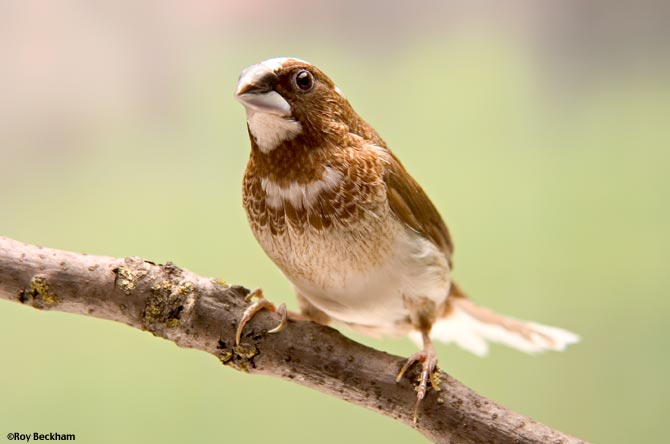




 |
|
|||||||||||||||||||||
 |
|
|
|
|
|
|
|
|
|
|||||||||||||
|
|
|
|
|
|
||||||||||||||||||
|
|
|
|
|
|
|
|
|
|
||||||||||||||
|
|
|
|
|
|
||||||||||||||||||
|
|
|
|
|
|
|
|
|
|
||||||||||||||
|
|
|
|
|
|
||||||||||||||||||
|
|
|
|
|
|
|
 |
|
|||||||||||||||
 |
 |
|
||||||||||||||||||||
|
|
|
|
||||||||||||||||||||
|
|
|
|
|
|
|
|
|
|
|
|
|
|
|
|
|
|
|
|
|
|
|
|
| Society Finch - Lonchura striata domestica | ||||||
 |
||||||
| Pied Chestnut Society Finch | ||||||
|
Common Names Description It used to be believed that the Society finch was a fertile hybrid developed from unknown members of the Lonchura family. Tests have shown that the Society finch is a domesticated form of the White-rump mannikin. Just one look at the Chocolate self and a White-rump mannikin and there can be no doubt of their relationship. Color Varieties There are a few other mutations and colors. Dominant pieds that are mostly white, all white birds, true albinos, a dilute called creamino and there is a trend in Europe to hybridize the Society with other Lonchura to introduce different colors. The Black Browns are an example of their efforts. There are also a number of feather mutations like crests. There are numerous frills that cover nearly every part of the body, including things like chest frills that cause the feathers on the breast to point out or upwards. I personally do not find these all that attractive. While combinations of the color modifier mutations (Gray, Pearl, Dilute and Ino) are possible with any of the base colors (Chocolate, Chestnut and Fawn), the base colors cannot be combined except in purely random occurrences. Some birds showing Chocolate, Fawn and White on one bird have been produced and are called Tri-colors (not to be confused with Tricolor nuns) but cannot be reproduced. Diet Breeder's Notes They will take a variety of nestboxes, baskets or just about anything that will hold them and their eggs. I prefer to use a standard finch nestbox with a half open front (click to see). Some of them are master nest builders, but most are happy with just a few strings, feathers or other materials dropped in the box. Incubation will begin sometime after the third egg, but some pairs can get so excited about the whole process that they may start after the first egg. If this occurs, it is possible to remove the eggs as they are laid and replaced with dummy eggs until a full clutch is gathered with the usual clutch ranging from 4 - 8 eggs. This is rarely necessary though. Incubation lasts for approximately 13 days and then pink and naked chicks are born. The Society finches are diligent parents and will take care of even very large clutches. Some pairs can be intolerant of chicks that lag behind in size due to a late hatch, while others have no problems. The chicks will fledge in approximately 21-25 days and are independent with another 2-3 weeks out of the nest. The entire family will continue to roost in the nest at night. Any chicks left with the parents after independence will stay in the nestbox and may even help with incubation and feeding duties with the next clutch, but it is often better to remove them for the same reasons you would remove other adult Society finches. You must actively stop the breeding pair after the desired number of clutches has been raised or they will continue to raise clutch after clutch. It is at this time that I will keep a large group of them together. No nestbox is necessary for roosting as they will all clump together for the night. They will attempt to breed as young as 3 months, but as with many species, it's best to wait for them to reach 6-8 months before breeding. If you intend to use them as fosters, it is best not to let them join other Societies that are breeding. They should be completely new to breeding when you foster another species under them. The only exception to this practice might be with pairs that you intend to use to foster other mannikin species. These are generalities and more than with just about any other species, there are exceptions. Additional Notes The Society finch is such an excellent parent that it is often used to foster many other species of estrildids. Many are quite different from the young of the Society finch. For more information on fostering with Society finches visit our page on fostering, and be sure to read Robert Black's book, "Society Finches as Foster Parents". The Society finch will also hybridize with many other finches. It is usually quite easy to hybridize with other members of the Lonchura family and some of those crosses produce fertile young. The Society finch will cross with many other finches that are not closely related such as Zebra finches (T. guttata castanotis). I purchased some unknown hybrids at a pet shop. After much deliberation, it was decided that these were Society x Star finch hybrids. (click to view the hybrids). |

A Pearl Society Finch . See the mouth markings of nestling Societies
